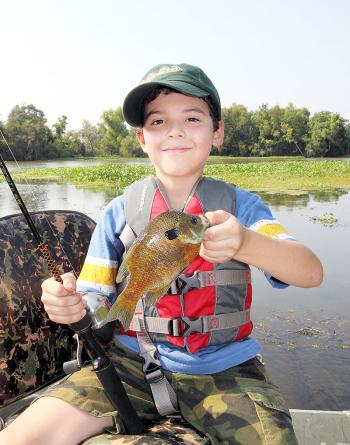
The Daily Review Outdoor writer John K. Flores’ grandson, Gabriel Flores, holds a good bluegill. (Submitted Photo/Courtesy of John K. Flores)
Flipping the switch on spring panfish
When it’s on, it’s on for panfish, and if you’re like me, you can’t wait for it each spring during the latter part of April and May.
There’s nothing more fun, in my opinion, than catching an ice chest full of chinquapins — redear sunfish for those who don’t know them by this name — and other bream species like bluegills and warmouth (aka: goggle eye to locals).
These species of freshwater fish are fun to catch, and pound for pound, they put up every bit the same tussle you would expect from those larger game fish that get most of the attention around this region. And in the frying pan, there are few fish that taste better.
But, what makes these fish even more special is you don’t have to travel long distances by boat to catch them; it doesn’t take a lot of special tactics nor does it take special tackle.
May, June and July are prime spawning months for all of these sunfish. Typically, when the water temperature reaches 68 to 75 degrees is when it’s best. The early part of the season can be tricky, because cold water from the northern spring thaw sends a lot of cold water down the Mississippi River and subsequently Atchafalaya River, influencing water temperature. However, it only takes a few warm days strung together for these fish to “turn on,” as they say, and get busy doing what fish do at this time of year.
Male bluegills and redear sunfish will congregate in an area and start fanning out a nest in shallow water. From the nest, they attract females enticing them to spawn.
It’s not uncommon for anglers to catch 30, 40, 50 or more bream from a spawning area during this time of year. Not to worry when considering these kinds of numbers. Most of these species will lay thousands and tens of thousands of eggs when they spawn.
You still have to find bream to catch them. And one of the things to think about is water condition. Bream don’t like a lot of fast moving water. They’ll stack up in places where water movement exists but is much more gradual like shallow grassy areas along lake edges, or downstream of a point just below the drop off. They’ll also be situated out of the current behind cypress trees. And might I also add — “Big Time!”
Local angler Manual Rodrigue is a 69 year old retired longshoreman who fishes chinquapins during the spring and summer months. One of Rodrigue’s favorite places to go is in the spillway in the Shell Field Canals out of Adam’s Landing.
Rodrigue said, “I always catch fish in the 16- and 30-inch canals near the Shell Oil Field cut, and I’ll fish around the cypress trees for chinquapins there. But, I look for fallen trees and submerged stumps and logs, and they’ll be around places like that, too. I’ll also fish sloughs and little drains that most people will pass up. The thing is, usually when you find them, you’ll find a bunch and rack up on them.”
The best bait for bream is live bait in the form of worms and crickets. The drawback to fishing with crickets and what most people don’t realize is bluegills suck in their food. Quite often the soft crickets are sucked off the hook by little bait-stealing fish, where you can go through a good many of the insects before landing a keeper big enough to fry.
By contrast, a good old night crawler worm is hard to beat. Worms are live wiggly bait that can take a lot of hits catching a few bream before having to be replaced. Other bait for bream includes kernels of corn and Berkley Powerbait Crappie Nibbles.
Plastic crappie baits like tube jigs also catch panfish. Good spring colors are black and chartreuse, pink and white and blue and white. When hooks with plastics are tipped with a little kernel-size piece of worm, it’s a tough combination for a perch to pass.
The later it gets towards mid-summer when temperatures reach into the high 80s and 90s, bream will still be in these same locations but often a little further off the bank when they were spawning in 1 to 2 feet of water. Also, the better fishing is early in the morning and late in the afternoon, when the edge is off the higher temperatures. In short, the fish like their comfort, too, where anglers have to adjust.
Like a switch, the bream bite turns on. When the switch is flipped in the right position, it’s time for anglers to get on the water. And there’s no better time than right now.
- Log in to post comments
